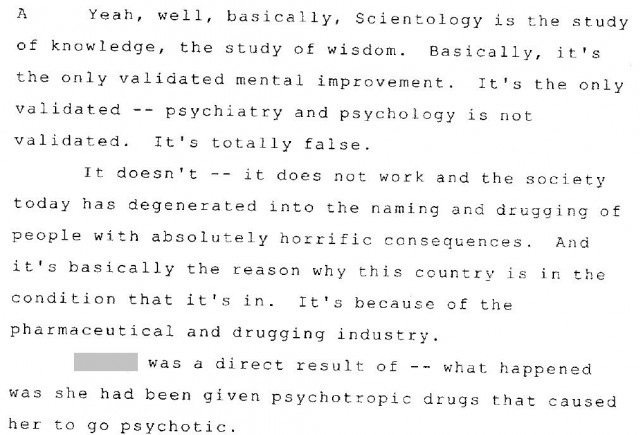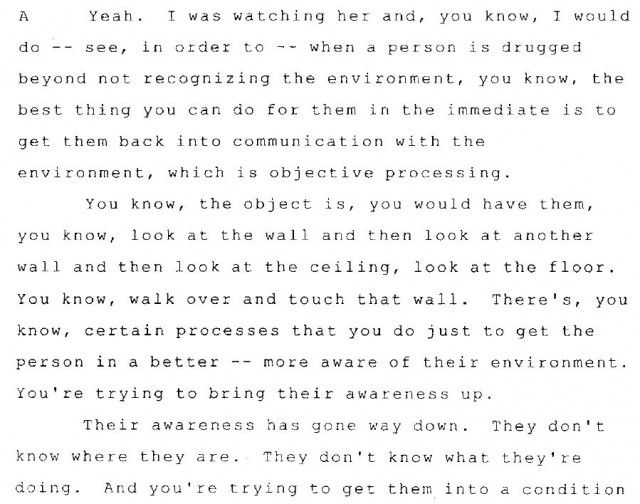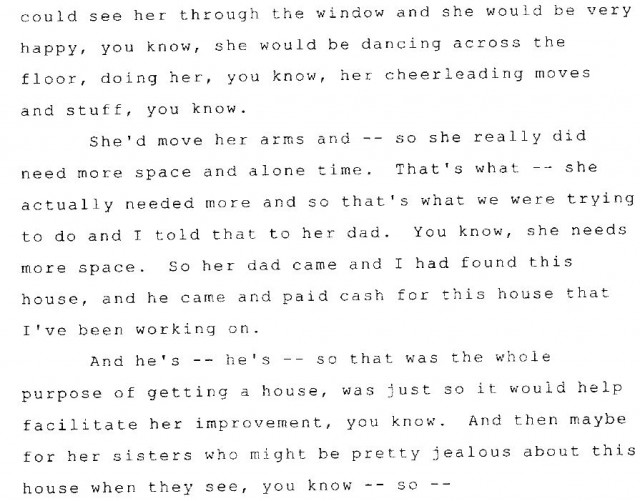Last May, in a small Arkansas town, a sheriff’s deputy arrived at a large house to help an ambulance crew with an unusual call.
He went into the basement of the house, which had a ground floor entry, and on the stairway leading to the kitchen on the next floor there was a woman sitting on the stairs.
We’re going to call this woman Candace. She was with her caregiver, a man we’re going to call Jim.
Here’s how the sheriff’s deputy described the scene in an incident report which was obtained by the Underground Bunker…
Upon my arrival, [Candace] was on the stairwell to the house with her caregiver trying to get her down the stairs. She was extremely bloody and her skin appeared to be blue as if she had already lost a tremendous amount of blood. She was refusing to come down the stairs but she was bleeding very badly and there was blood all over the area where she was at.
The 32-year-old woman had cut her hand, deeply, in what appeared to be a suicide attempt — her caregiver, Jim, would later claim she had broken a small bottle in frustration and had accidentally hurt herself.
The deputy watched as the ambulance crew and Jim tried in vain to get her down the stairs. Jim explained that “she had mental issues and he was paid to care for her,” the deputy noted.
Another deputy had to handcuff Candace to get her down the stairs so they could get her on a gurney and into the ambulance. But before the ambulance could drive away, Candace escaped from the vehicle and began running away.
She was caught, and then she was bundled into the back of a patrol car that took her to a local hospital.
Her condition was shocking, the first deputy noted.
She smelled as if she had not bathed in about two months. Her hands and toes were black with dirt. Her hair was matted into a knot….I was contacted by the doctor at the ER who advised that he had some bungee cords that it appeared that she had been tied up with. He advised that she has some ligature marks on her wrist that were consistent with being restrained.
For more than a year, Candace had been held in a basement in a small Arkansas town, and was found with evidence that she had been tied down with bungee cords, allowed to live in filthy conditions, and was malnourished.
Her caregiver, Jim, has not been charged with a crime. But he was surprisingly candid when he was asked later in a sworn deposition to explain how and why a malnourished, filthy woman had lived in his basement — and while he got paid $750 a week to “care” for her.
It turned out that he was happy to explain the situation. He was a Scientologist, the treatment he was giving the woman was standard Scientology “technology,” and the year before, his treatment of her had begun at a Scientology-style rehab facility in the Tennessee countryside.
In fact, Jim was convinced his care was the only way Candace would ever get well, and he was fighting to get custody of her, so he could continue to heal her with Scientology.
Today, Candace is a ward of the state of Arkansas, deeply unwell and living at a state hospital. And this is how she ended up there.
In Going Clear, Alex Gibney’s documentary which airs on HBO March 16, portions of an interview with Scientology founder L. Ron Hubbard are shown that were filmed in May 1966 at Hubbard’s English estate, Saint Hill Manor.
At one point, Hubbard is asked if Scientology is an “extension” of psychology and psychiatry, and he makes a face.
“Don’t associate Scientology with such people! That’s terrible, that’s bad manners, you know,” Hubbard says with a laugh. Then he explains how Scientology was meant to make the able more able, and it wasn’t designed to heal the mentally unwell: “Psychotherapy…that’s for the neurotic or the person who is insane or something like that. It has nothing to do with Scientology. Scientology is for an able guy like you, or like me, able to function in life, able to make his own way, does his work and so forth.”
A few years later, Hubbard changed his mind about that. By 1973, he was running Scientology from the deck of the yacht Apollo after he’d been chased out of the United States and the UK by investigations and process servers. At some point that year on his journey through the Mediterranean and Atlantic, a crew member had a nervous breakdown and became violent. Hubbard’s solution was to lock the man up in a cabin and deprive him of all human contact except for a single auditor (Scientology’s version of a counselor). The man calmed down, and Hubbard announced that his method — which he called the “introspection rundown” — was the answer to handling all individuals suffering from psychoses.
Hubbard hated psychiatry, and to this day one of Scientology’s most active front groups, the Citizens Commission on Human Rights (CCHR) maintains a facility on Sunset Boulevard in Hollywood called Psychiatry: An Industry of Death Museum.
But Scientology not only believes that the psychiatric profession is a fraud. It also believes it has the answers for treating serious mental illness. And that belief has repeatedly resulted in disaster.
The most well known example of the Introspection Rundown ending badly happened in 1995, when Lisa McPherson, a church member from Texas, was involved in a minor car accident in Florida and, though she appeared unharmed, took her clothes off in the middle of the road. When doctors tried to give her a psychiatric examination, her fellow Scientologists took her out of the hospital and instead installed her in the Fort Harrison Hotel in Clearwater, Scientology’s spiritual headquarters. She was then subjected to the Introspection Rundown, and workers were told not to speak with her as she was held in isolation, only to deliver her food and water. Scientologists have another name for the rundown — they call it the “baby watch.” Seventeen days after Lisa McPherson’s baby watch began at the hotel, she was dead. Experts who reviewed her autopsy concluded that she had died of extreme dehydration — she had simply not taken the food or water she was given, and without any way to communicate to her handlers, she had died of neglect.
Another organization might have concluded that it didn’t have the expertise to handle people suffering serious mental illness. But in Scientology’s case, that would mean admitting that its founder Hubbard and his Introspection Rundown weren’t the solution he claimed it to be. And if there’s one thing Scientology cannot do, it is invalidate Hubbard.
So, Scientology has continued to subject mentally ill people to its baby watch, but it has become more careful not to have it happen at its own facilities.
There was precedence for this. In 1987, Scientologists had opened a ranch-style school for children in Palmdale, California that later moved to New Mexico. It was run by a man named Wally Hanks, and it was intended to be a place where parents could send their troubled teenage children for Scientology training.
In 2009, Hanks was recorded in a telephone call, and he complained that Scientology used the ranch as a place for “dumping” adults with mental problems.
“What really caused the ranch to go bad was that dumpin’ them fucking psychotic cases in there. I was told to run a kid’s ranch but they kept dumping them fuckin’ psychotic cases….It wasn’t psychotic kids, it was psychotic adults. You know that they dumped on me out there, because the church don’t give a shit about them people,” Hanks said.
Today, the place of choice for unwell adults that Scientology doesn’t want to deal with appears to be a bucolic facility in the hills of Tennessee.
Last year, we told you the troubling story of Barbara Cordova Oliver. She was a familiar face at Scientology’s Hollywood Celebrity Centre and had run events there. But after she suffered a nervous breakdown, she was made to disappear.
Her mother, Arlene Cordova, asked us for any help we could give, and with the aid of our readers we learned that Barbara had been taken to a facility in the town of Woodbury, Tennessee named Life Center for a New Tomorrow.
Life Center is owned by a longtime Scientologist, Marc Vallieres, and it offers a non-medical program that is similar to Scientology’s rehab network, Narconon. But Life Center is not a Narconon unit, and it appears to have no formal ties to the Church of Scientology, other than a recommendation from the Oregon chapter of CCHR.
When we called Vallieres last year to ask about Barbara, he told us we might get some answers if we called Scientology’s Hollywood Celebrity Centre. It was a strange but telling response. Vallieres appeared to acknowledge that Scientology itself was guiding Barbara’s treatment, and Vallieres refused to tell us anything further.
We called him up again a few weeks ago, this time to ask about a young woman named Candace.
“I have no information,” he told us.
We asked again what the connection is between Life Center and the Church of Scientology.
“There is no connection,” he answered.
“You use Scientology techniques, right?” we asked.
“You caused me a lot of trouble before, and I don’t understand why I should talk to you today,” he said.
Trouble? We suggested his facility might have caused Candace some trouble.
“I got no comment. No comment,” he said, and he hung up.
It was another frustrating encounter with Vallieres, but we really didn’t need him to tell us what happened at Life Center, because it was explained in detail by an employee there — Candace’s caregiver, Jim — and in a sworn court document.
In October, five months after Candace was found, filthy, bleeding, and malnourished in Jim’s Arkansas basement, he sat down for a deposition with an attorney representing the Office of the Public Guardian, which is part of the Arkansas Department of Human Services.
The circumstances were bizarre.
After Candace was taken from Jim’s basement to a hospital, she was in bad enough shape that the Public Guardian had filed a petition in court to gain legal custody of her. But the agency had competition. Another petition had been filed by two men, represented by an attorney.
They were Candace’s father, who we’ll call Glen, and Jim — yes, the same person who had taken care of Candace by keeping her in a basement.
By October, Glen and his attorney had pulled out of the petition, so when the attorney for the Public Guardian sat down to depose Jim, the caregiver was now alone in opposing the Public Guardian’s office in a court battle to take over legal custody of a woman now confined to a state hospital.
The attorney began questioning Jim, obviously curious why he still wanted control over Candace, and interested in what he would say while being questioned by the attorney representing the agency fighting Jim for that control. Would he be combative?
Instead, Jim was cooperative. In fact, he seemed eager to explain all of the good things that he had done for Candace by treating her with a particular brand of counseling. He was eager to tell the attorney how psychiatry was nonsense, and only something called Scientology could help the mentally ill.
In the fall of 2012, Candace arrived at Life Center for a New Tomorrow, where Jim worked as a supervisor.
The Woodbury facility had been granted a license by the state’s Department of Mental Health and Substance Abuse Services in 2009.
Jim explained that Life Center was a place for helping people “detoxify” from psychotropic drugs. It was his job to help them get weaned off their “psych” drugs and then try to get them back into normal activities. Some of the men he’d worked with, for example, he had taken on fishing trips, including a man who had been an executive at Apple.
“And I would do certain types of Scientology processes on him. I’m a Scientologist. I’ve been a Scientologist since I was 15 years old,” he explained. He had worked for 11 years in a particular Scientology division that we’re not going to name for now. Jim wanted the attorney to understand that Scientology was the only hope for someone like Candace…
The attorney asked if Life Center was connected with Scientology’s Narconon rehab network. Jim said it wasn’t. But he wanted the attorney to understand Scientology’s position on psychiatry. He recommended that the attorney watch a film made by Scientology’s Citizens Commission on Human Rights titled Making a Killing: The Untold Story of Psychotropic Drugging. Jim repeated that offer numerous times over the course of the deposition.
(CCHR’s film was made by a man named Randy Stith. In December, Stith showed up in a strange ambush of former Scientology executive Mark “Marty” Rathbun at a Hollywood studio where he had been filming scenes with Louis Theroux for an upcoming BBC documentary.)
Jim was asked what kind of condition Candace was in when she arrived at Life Center.
“She was in pretty bad shape.” Was she psychotic? “Absolutely.”
It was her father, Glen, who had brought her to the facility. (A family member tells us that as far as she knows, neither Candace or her father were members of Scientology.)
The attorney then asked if it were true what he had been told — that after Candace checked in to the center, she had been assigned to live alone in a mobile home with him.
Claire Headley, a former “Sea Org” worker who escaped from Scientology’s secretive International Base near Hemet, California in 2005, helped us understand “objective processing” during our series that looked at Scientology’s courses step by step. The “objectives” occur relatively early in a church member’s journey up “the Bridge to Total Freedom.”
(The touching of walls and windows in objective processing was captured visually in a striking scene with Philip Seymour Hoffman and Joaquin Phoenix in Paul Thomas Anderson’s 2012 film, The Master.)
Besides asking Candace to look at the walls and floor and ceiling, Jim said he also had her “detox” in a sauna, which is another Scientology method. And Jim said that after only a week, she showed progress after being weaned off of the medications she’d been taking.
How did he know she was getting better?
“Within the first week that I had her, I had her aware enough to where she actually stole my truck and drove it to Tallahassee, Florida,” Jim explained.
Jim continued to explain how his Scientology concepts had helped get Candace into “present time.” But the attorney wanted to make sure he had heard correctly.
“So when she was getting better, she stole your truck and ran away,” he asked.
“Yeah. When she was becoming more aware, she was like — she had to get out of there.”
Candace went to her mother’s house in Tallahassee, but Jim found her and brought her back to Tennessee. Later, Candace stole his truck again and was arrested on her way to Nashville.
But Jim insisted that she was improving during her six months at Life Center, living alone with Jim in a mobile home. At $2,000 a week, however, Candace’s father was apparently having a hard time justifying the cost.
At some point, Jim had begun talking to Candace about taking her away from the facility.
Jim had an uncle in Arkansas who had recently died. His aunt was there in a large house, and Jim began to talk to Candace and her father about moving her there. Instead of Glen having to pay Life Center $2,000 a week, Jim would take care of Candace in Arkansas, and for only $750 a week. Glen agreed to the deal.
In March 2013, Jim moved Candace to his aunt’s home in Arkansas, and put her in its ground floor. When the attorney asked if it was in fact the building’s basement, Jim got defensive.
“Yeah, we’re talking about — this was another slanderous-type comment made. OK….The property is, like five acres and it is a spectacularly beautiful place,” Jim answered, and explained that his recently deceased uncle had been a major player in state Republican Party politics. “Now, the house does not have a underground basement…It’s a very nice home, a two-story home, and in the front it’s ground level. It’s ground level on the front and what we did was, we rented the entire first floor of the house,” he answered. But later, when the attorney asked him if it were true that part of the floor was underground, Jim admitted, “Yeah…I was told, technically, it’s a basement.”
The attorney asked Jim to describe it. Jim answered that there was a small kitchen unit that they never used — he cooked her meals upstairs, on the actual first level — and Candace slept on a narrow bed, a single.
And where did Jim sleep? On the floor, he said. For more than a year?
“Yeah, it was pretty rough, but what it was — it was just a temporary thing until we could get her own place. And we actually did that, and two days before [Candace] cut her hand we had bought a place. And it is…2,200 square feet and when I’m done with it — I’ve been working on it.”
Two months after she arrived in Arkansas, Candace was visited by her father, Glen. (No family members had visited her during her six months at Life Center for a New Tomorrow.)
The attorney explained to Jim that Glen had written a letter to a doctor about his visit that had ended up in a file the attorney had access to. “He described her as…having long fingernails, dirty fingernails, dirty toenails, matted hair…”
But for everything that had come up in the letter and later in the incident report when she had cut her hand, Jim had a ready explanation.
She had stopped bathing, he said, because she didn’t like the soft water at his aunt’s house.
“She had really nice fingernails…See, [Candace] didn’t stink…Most psychotics, they stink. And [Candace] didn’t smell and she didn’t go out and get dirty. You know, she had all of her clothes there and she would be particular about what she wore. So she didn’t really like to change her clothes very much.”
The bungee cords? A volunteer ambulance driver had brought those to the scene.
The ligature marks on Candace’s wrists? They were marks left from her scratching at chigger bites.
Was it true that he allowed her to smoke cigarettes? Yes, she was a smoker.
“So it was OK, with all of the detox and conditioning and everything else, it was OK for her to smoke?”
“Yeah. Yeah. It was OK for her to smoke.”
“But that’s a drug. That’s nicotine.”
“Yeah. Yeah. That’s right, it’s nicotine. But we’re not talking about something that causes you to think that there’s somebody next to you talking to you. We’re not talking about that. We’re talking about cigarettes. It’s a having — actually having a cigarette is a havingness-type thing,” Jim explained, using a word invented by Scientology founder L. Ron Hubbard.
Jim also objected to the idea that Candace had been malnourished. In fact, he had made her “gourmet” meals three times a day, and she had become sensitive about gaining weight while she was in Arkansas. Jim said she would become very upset if the word “fat” was used around her after she had gone from about 90 pounds to 125, he claimed. She had only refused to eat one of his “gourmet” meals a couple of times. He said it was “a total lie” that the hospital had reported that Candace was malnourished.
Jim especially seemed to want the attorney to believe that he was a very good cook.
The attorney appeared unimpressed by Jim’s plan for the new house.
“Did she actually try to stab you?”
“Yeah. She stabbed me twice.”
“With what?”
“Her steak knife.”
But Jim pointed out that there were just the two incidents in a period of almost two years that he had worked with Candace.
As for how she cut her hand, Jim said he had been cooking for her upstairs when she began pounding on the door at the top of the basement stairs. His aunt, however, wouldn’t allow her upstairs, so there was nothing Jim could do. And while Candace was pounding away, she had a small glass bottle in her hand that shattered, cutting her hand.
“Were you aware she called you Lucifer when she was in the hospital?”
Jim said it was just the drugs talking — the psychotropic drugs the hospital had put her on after all of his hard work to keep her off of them.
Why, the attorney asked, would Candace say that Jim had shocked her with electicity?
Jim again blamed the drugs she was on, and if he could only see her she would actually ask to leave the hospital and go with him again.
“Are you aware that she has been asked if she wanted to come back and live with you or if she wanted to live with her father? And she says, no.”
Once again, Jim blamed the drugs Candace was taking.
“This whole thing will, all the way down to the end, it is being reported. I make all these reports to the Citizens Commission on Human Rights. Everything gets reported. That’s the producers of this Making a Killing,” Jim said. He didn’t care about making any money. He only cared about getting Candace back off of drugs, and having her join him at the house that he was renovating with the help of her father.
Jim at least was realistic about his chances of gaining custodial control over Candace. He knew that without the financial backing of her father, who had already pulled out of the petition, he had little hope of continuing her “care.”
After the deposition, Jim did show up at the court hearing to decide Candace’s fate. The public guardian won that battle, taking custody of Candace, but a family member blames Jim’s interference for causing the judge to grant the public guardian only temporary custody. Another court hearing will follow.
When we reached the Public Guardian, he told us he couldn’t comment on the case. We submitted requests to the prosecuting attorney in the county where Candace was rescued from her basement prison about whether he was contemplating charging Jim criminally, but he did not respond.
Candace is deeply unwell and living in a state hospital in Arkansas, and a family member tells us it is not a facility she wants to see Candace remain in. The family member says she is looking into legal remedies.
In Alex Gibney’s movie Going Clear, Pulitzer Prize winning author Lawrence Wright describes L. Ron Hubbard’s ideas about the human mind as “psychological folk art” that has been completely dismissed by the medical community. And yet, across the country, local governments continue to license Scientology-affiliated facilities for treating vulnerable people. The deaths of patients at Scientology drug rehab clinics in Michigan, Georgia, and Oklahoma have produced numerous government investigations, but not a single facility has lost its license as the direct result of a patient death. (The Georgia facility was shut down over allegations of credit card fraud.)
A week after Jim gave his deposition about Candace in October, the Tennessean reported that the state Department of Mental Health and Substance Abuse had found Life Center for a New Tomorrow in violation of its license. An inspection found 21 deficiencies at the facility, including a failure to do criminal background checks on employees. Marc Vallieres agreed to a correction plan.
In particular, the inspection found that one of the patients “did not meet state requirements for self care. Those requirements include the ability to bathe, eat, take care of their possessions, recognize danger and maintain appropriate and tolerable behaviors.”
In other words, more than a year after Life Center had handled a severely ill person like Candace, it was still taking on very challenging cases that Scientology’s processes of “psychological folk art” are woefully inadequate to handle.
The state indicated that it might revisit the center in order to check compliance. Next time, it might want to look even more closely than that.
——————–
Bonus photos from our tipsters
Actual caption on his Instagram photo taken at the Hollywood Celebrity Center: “Let’s get back in track with my classes to have better tools for life!! I love it #scintology #LRH”
Scientologists are using social media more than ever. Drop us a line if you spot them posting images to Instagram or Facebook!
——————–
Posted by Tony Ortega on February 2, 2015 at 07:00
E-mail your tips and story ideas to tonyo94@gmail.com or follow us on Twitter. We post behind-the-scenes updates at our Facebook author page. Here at the Bunker we try to have a post up every morning at 7 AM Eastern (Noon GMT), and on some days we post an afternoon story at around 2 PM. After every new story we send out an alert to our e-mail list and our FB page.
Learn about Scientology with our numerous series with experts…
BLOGGING DIANETICS: We read Scientology’s founding text cover to cover with the help of LA attorney and former church member Vance Woodward
UP THE BRIDGE: Claire Headley and Bruce Hines train us as Scientologists
GETTING OUR ETHICS IN: Jefferson Hawkins explains Scientology’s system of justice
SCIENTOLOGY MYTHBUSTING: Historian Jon Atack discusses key Scientology concepts
PZ Myers reads L. Ron Hubbard’s “A History of Man” | Scientology’s Master Spies | Scientology’s Private Dancer
The Underground Bunker’s Official Theme Song | The Underground Bunker FAQ















